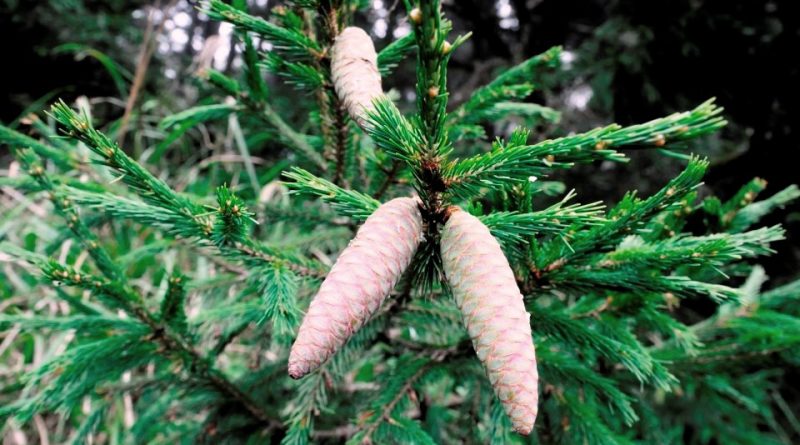Picea morrisonicola
Picea morrisonicola
The Taiwan spruce or Mount Morrison spruce (Picea morrisonicola Hayata, 1908) is an arboreal species belonging to the Pinaceae family.
Systematic –
From a systematic point of view it belongs to:
Eukaryota domain,
Kingdom Plantae,
Pinophyta Division,
Class Pinopsida,
Pinales Order,
Pinaceae family,
Genus Picea,
Species P. morrisonicola.
Etymology –
The term Picea comes from picea, the Latin name of the wild pine in Virgil and Pliny.
The specific epithet morrisonicola refers to Mount Morrison, an English name once used to indicate Mount Yu Shan, the highest mountain in Taiwan.
Geographic Distribution and Habitat –
Picea morrisonicola is an endemic conifer found only in Taiwan and is the only spruce species in Taiwan. It is the southernmost spruce species in the world; the largest stands are found in the Ta Ta Chia area, in the central mountains, just north of the Tropic of Cancer.
Its habitat is in the high mountains from 2300 to 3000 m above sea level, preferring the northern slopes and ravines, on acid and podzolic soils; the climate of the habitat is cold temperate, extremely humid and characterized by monsoon-like rainfall (over 4000 mm per year). It is found in mixed forests in association with other conifers, such as Tsuga chinensis, Pseudotsuga sinensis, Pinus armandii, Abies kawakamii and Juniperus squamata var. morrisonicola; at lower altitudes also with Chamaecyparis obtusa var. formosan. The deciduous trees include Quercus varias and species of the Acer and Betula genera.
Description –
Picea morrisonicola is an arboreal species that can grow up to 40-50 m with wide and conical foliage, which becomes irregular and open in older specimens.
The trunk is monopodial, straight and can reach 1.5 m in diameter.
The bark is gray or grey-purple in colour, with a wrinkled, furrowed consistency and is divided into rounded plates, flaking easily.
The branches of the first order are long and massive, developed horizontally, with the terminal part curved downwards; those of the second order are numerous, short. The shoots are slender, flexible, the new shoots only 2 mm thick, initially pale yellow above and almost white below, then grey, glabrous or rarely pubescent, with a furrowed and rough surface; the pulvini are small and reddish.
The leaves are needle-like, perpendicular; they are 1-1.5 cm long, linear, usually curved, with a square-rhombic or polygonal section, with acute or obtuse tips; they have stomata on both pages, arranged in 2-3 lines in 2 bands on the upper ones, in 4-5 lines on the lower ones.
The needles are green or dark-green, with greenish-white stomatal bands.
The buds are ovoid-conical, 3-4 mm long, slightly resinous; the perulae are triangular-ovate, dark brown-red in color, persistent for several years.
The male strobili are axillary, 1-1.5 cm long, yellow.
The female cones are initially erect, then pendant, terminal, oblong-ovoid with a truncated base and obtuse apex, sessile or with a short and oblique peduncle, 5-7 cm long and 2.5-3 cm wide, red-greenish or purple- greenish when immature, then brown. The macrosporophylls are obovate or suborbicular, 1.2-1.5 cm long, with a finely striated or smooth, glabrous surface, with an entire, rounded or truncated upper margin and a truncated lower base. The bracts are ligulate, rudimentary, purple, 2-3 mm long and entirely included. The seeds, ovoid-oblong, are dark brown, 3-3.5 mm long, with an ovate-oblong winged part, 8-10 mm long, of a light yellowish or orange-brown colour.
Cultivation –
Picea morrisonicola is a conifer that grows at altitudes of approximately 2300 to 3000 m in the central mountain range of Taiwan, in ravines and mountain slopes, usually mixed with other trees.
This plant grows predominantly in its natural state but its populations have declined drastically, due to overexploitation, as it is one of the most important woody species in Taiwan.
This plant grows high in the mountains on acidic and podzolized soils.
The climate is cold temperate, monsoonal and very humid, with annual rainfall exceeding 4000 mm.
Propagation occurs by seed.
Customs and Traditions –
Picea morrisonicola was first described by Bunzō Hayata and published in the Journal of the College of Science, Imperial University of Tokyo 25(19): 220. 1908.23.
It is known by some common names, including: Taiwan spruce, 台湾云杉, Taiwan yunshan (Chinese).
This conifer can grow to large sizes and is a valuable timber tree, but has been overexploited in the past and is now relatively rare. Wood is used for construction, carpentry and furniture making.
It was introduced to Europe and North America in 1918, its cultivation being limited to specialized vegetable gardens and botanical gardens.
As regards its conservation status, the exploitation of its wood, with consequent deforestation, has caused a reduction in its primary range, estimated at 30-50% over 150 years. For this reason it is classified as a Vulnerable Species in the IUCN Red List.
Preparation Method –
Picea morrisonicola is a fir tree exploited mainly for its wood while cultivation is limited to specialized vegetable gardens and botanical gardens
Its wood was of economic importance in Taiwan, before the species became rare due to excessive deforestation. It is used in construction, carpentry and for the manufacture of furniture.
Guido Bissanti
Sources
– Acta Plantarum – Flora of the Italian Regions.
– Wikipedia, the free encyclopedia.
– GBIF, the Global Biodiversity Information Facility.
– Useful Tropical Plants Database.
– Conti F., Abbate G., Alessandrini A., Blasi C. (ed.), 2005. An annotated checklist of the Italian vascular flora, Palombi Editore.
– Pignatti S., 1982. Flora d’Italia, Edagricole, Bologna.
– Treben M., 2000. Health from the Lord’s Pharmacy, Advice and experiences with medicinal herbs, Ennsthaler Editore.
Photo source:
– https://inaturalist-open-data.s3.amazonaws.com/photos/26544960/original.jpeg
– https://www.conifers.org/pi/pi/m/morrisonicola01.jpg
Attention: Pharmaceutical applications and food uses are indicated for informational purposes only, they do not represent in any way a medical prescription; we therefore decline any responsibility for their use for healing, aesthetic or food purposes.


